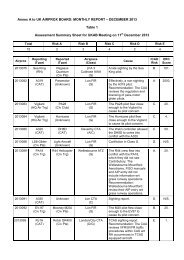STATISTICS 2016
DUKES_2016_FINAL
DUKES_2016_FINAL
Create successful ePaper yourself
Turn your PDF publications into a flip-book with our unique Google optimized e-Paper software.
derive heat sold figures since 1999. When information about where the heat was generated was not<br />
available from the BRE sources, it was assumed that domestic sector heat consumption was provided<br />
by the commercial sector, public sector heat consumption was provided by the public administration<br />
and industrial sectors (using proportions derived from CHP statistics) and that industrial sector heat<br />
consumption was provided by the industrial sector. The introduction of heat sold into the energy<br />
balances has not affected the individual fuel totals, since the energy used to generate the heat has<br />
been deducted from the final consumption section of the energy balance and transferred to the<br />
transformation section. The figures that are included in the balances should be treated as indicative of<br />
the amount of heat sold. Annex J of the Digest, at: www.gov.uk/government/collections/digest-of-ukenergy-statistics-dukes<br />
shows the quantity of fuel by consuming sector used to produce heat that is<br />
subsequently sold.<br />
II Energy balances (Tables 1.1, 1.2 and 1.3)<br />
1.38 Tables 1.1, 1.2 and 1.3 show the energy flows as the primary fuels are processed (or used) and<br />
as the consequent secondary fuels are used. The net inputs to transformation are shown in the<br />
transformation rows and hence outputs from transformation processes into which primary fuels are<br />
input (such as electricity generation, heat generation or petroleum refining) appear as positive figures<br />
under the secondary product’s heading in the tables. Similarly the net inputs are shown as negative<br />
figures under the primary fuel headings.<br />
III Value balances (Tables 1.4, 1.5 and 1.6)<br />
Valuation of energy purchases<br />
1.39 In common with the rest of the chapter, these tables covering energy expenditure follow a<br />
balance format. While a user may derive data on a similar basis as that previously published, the<br />
balance tables allow for more varied use and interpretation of traded energy value data. That said,<br />
the tables continue to only show values for energy that has to be purchased and therefore do not<br />
include estimated values of a sector’s internal consumption, such as coal used in the process of coal<br />
extraction.<br />
The value balance<br />
1.40 The tables balances around market value of inland consumption, with the lower half of the<br />
tables showing the total value of consumption by end users, sub divided into energy sector users and<br />
final users both for energy and non-energy use. The top half of the tables show the supply<br />
components that go to make up the final market value of inland consumption, namely upstream cost of<br />
production, imports, taxes and the margins and costs of delivering and packaging the fuel for the final<br />
consumer. The total final consumers’ value of energy consumption is represented by the lines ‘total<br />
non-energy sector use’ and iron and steel sectors’ purchases of coal for use in solid fuel manufacture.<br />
1.41 All figures are estimates and have been rounded to the nearest £5 million.<br />
Fuel definitions in value balances<br />
1.42 Crude oil includes Natural Gas Liquids (NGLs) and refinery feedstocks. Natural gas does not<br />
include colliery methane. Electricity only includes electricity delivered via the public distribution<br />
system and therefore does not value electricity produced and consumed by autogenerators; however<br />
the fuels used by autogenerators are included under Transformation. Manufactured solid fuels<br />
include coke, breeze and other solid manufactured fuels, mainly products from patent fuel and<br />
carbonisation plants. Other fuels include all other fuels not separately listed, where they can be<br />
clearly considered as traded and some reasonable valuation can be made. Fuels mainly contributing<br />
to this year’s values are wood, coke oven and colliery methane gases sold on to other industrial users<br />
and some use of waste products such as poultry litter.<br />
Energy end use<br />
1.43 Values represent the cost to the final user including transportation of the fuel. They are derived,<br />
except where actual values are available, from the traded element of the volumes presented in<br />
22







